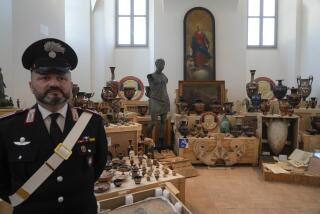Getty, Italy reopen talks on antiquities
- Share via
Days before a threatened cultural embargo was scheduled to take effect, the J. Paul Getty Museum has resumed negotiations with the Italian government over 46 of the museum’s disputed antiquities -- opening the door to a possible agreement.
In an exchange described by a Getty official as “intense” and “useful,” the museum has exchanged letters with Italy’s minister of culture, exploring possible settlements of the dispute, authorities from both sides confirmed Monday.
Neither side would provide details of the negotiations, but Getty spokesman Ron Hartwig said Monday that museum officials were “hopeful this will lead to a resolution.... We believe both sides are committed to resolving the issues that separate us.”
The apparent breakthrough comes after an eight-month deadlock and was made possible when Italy took off the table what had been a key sticking point in the talks: the fate of the so-called Getty Bronze, a 4th century BC statue of a young athlete found by Italian fishermen in the 1960s.
The statue is considered a signature piece in the Getty’s antiquities collection, occupying a climate-controlled room built specially for it at the Getty Villa, near Malibu.
A senior Italian official said the culture ministry decided that the fate of the statue should not be negotiated until a new criminal investigation into the statue’s discovery and export from Italy is complete. The official asked not to be named because he was not authorized to speak on the record while negotiations were ongoing.
The new investigation, being conducted by a regional magistrate, was requested several months ago by a local citizens group in Fano, hometown of the fishermen who found the statue, brought it ashore and hid it in a cabbage field before selling it to a local dealer.
But even its citizen sponsors admit the investigation is unlikely to uncover the full story of the artifact’s discovery and export from Italy. Nearly four decades have passed since the bronze athlete left Italy under mysterious circumstances, and many of the people involved have since died.
Even with the impasse broken, the Getty and Italy have tough negotiations ahead, including the fate of the museum’s prized statue of Aphrodite and several other of the collection’s masterpieces.
Italy first formally demanded the return of the bronze and 45 other antiquities in January 2006, saying the they had been illicitly excavated and smuggled out of Italy before being purchased by the Getty Museum.
Several of the artifacts have been used as evidence in the Italian government’s criminal case against Marion True, the Getty’s former antiquities curator who is facing charges in Rome of trafficking in looted art.
In November, the museum offered to return 26 disputed objects, but talks broke down over the bronze, which was not among the offered pieces. Italian authorities turned down the deal, saying they would only agree if all 46 objects were returned.
Earlier this month, Francesco Rutelli, Italy’s minister of culture, visited Fano.
In a speech there, he threatened to cut off all ties between Italy and the Getty if there was not an agreement by August 1st. The threatened embargo would be an unprecedented move by Italy, ending mutually beneficial collaboration in the areas of conservation, research and exhibition of art.
Cutting cultural ties could hurt Italy as much as the Getty. Museum officials say that since 1990, the museum has lent more than twice as many artworks to Italian institutions as it has borrowed from the country. They say they have made hundreds of thousands of dollars in grants to individuals and institutions for study and conservation, including more than $400,000 to Save Venice Inc.
Both sides have since issued statements saying they hoped to avoid breaking ties, but the bronze had stood in the way of further talks.
Of the 46 disputed objects, the bronze is a unique case. It was found in international waters before being brought into Italian territory, according to one of the fisherman who discovered the statue. That fact has muddied the legal waters and made the arguments over its ownership more contentious.
Italy maintains that the statue was later smuggled out of the country without an export license required by Italian law, and that it should therefore be returned. The Getty insists that illegal export alone, even if it were proven, would not constitute grounds for returning the bronze, which was originally made in ancient Greece and most likely looted by Roman soldiers.
Before his death, museum founder J. Paul Getty had qualms about both the $4 million asking price for the statue and about its legal status. He had concluded that the museum should only acquire the bronze if it received explicit permission from the Italian government to do so.
But in the months after his death in 1976, the museum bought the statue for just under $4 million without permission from Italy. Museum officials dubbed it the Getty Bronze in honor of the oilman.
The statue was the subject of a lengthy criminal trial in Italy in the late 1960s and ‘70s. Two dealers and a priest were charged with trafficking in looted antiquities and convicted by a court. That sentence was overturned on appeal, however, when Italy’s highest court ruled that, since there was no proof the bronze was found in Italian waters, there was insufficient evidence for Italy to claim it as stolen property.
But the question of how the statue left Italy was never resolved in the legal dispute, and for years Italy has called for the statue’s return.
“We think it should be called the Athlete of Fano, not the Getty Bronze,” said Tullio Tonnini, an attorney in Fano and member of the local cultural group Cento Citta which filed the request for a new investigation in April.
More to Read
Sign up for Essential California
The most important California stories and recommendations in your inbox every morning.
You may occasionally receive promotional content from the Los Angeles Times.










